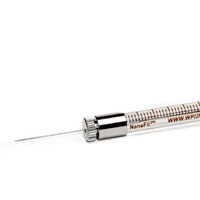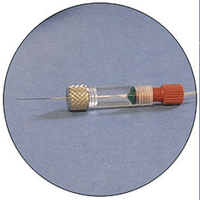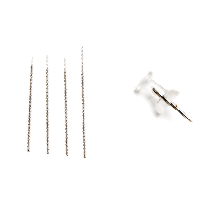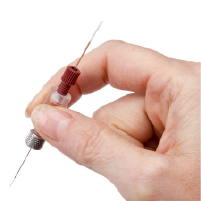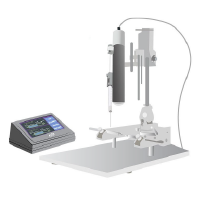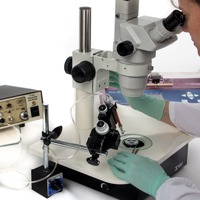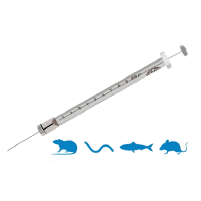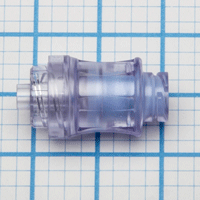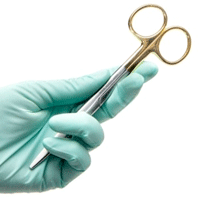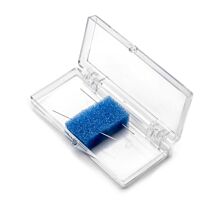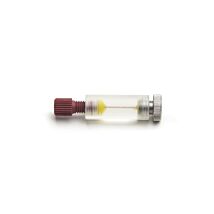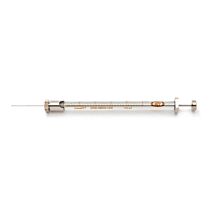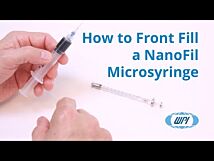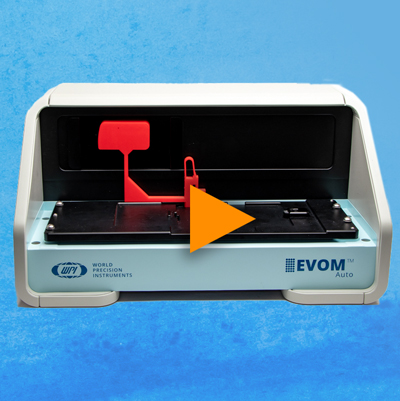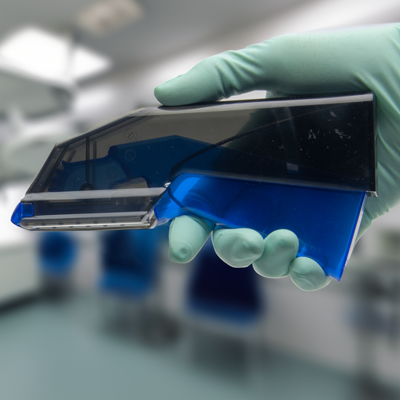This website uses cookies to ensure you get the best experience on our website.
Read more
Selecting the Correct Tip for Your NanoFil Microinjection Application
April 24, 2013
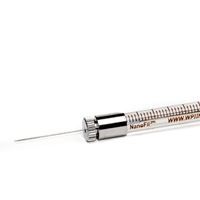
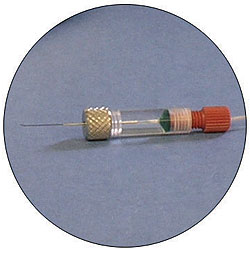 Specially designed tips as small as 36 gauge (110 micron OD) are offered in both blunt and beveled styles. Our studies have shown that these tips will cause less trauma to the tissue than any other form of micro syringe currently in use. NanoFil has a unique coupling mechanism that allows many different forms of small tubing and tips to be coupled with the syringe barrel.
Specially designed tips as small as 36 gauge (110 micron OD) are offered in both blunt and beveled styles. Our studies have shown that these tips will cause less trauma to the tissue than any other form of micro syringe currently in use. NanoFil has a unique coupling mechanism that allows many different forms of small tubing and tips to be coupled with the syringe barrel.
Configurations
Based on application requirements, NanoFil can be used in several different configurations.
Direct Microinjection by Hand
This is the simplest and most economical way to inject. Any of our tips can be inserted directly into the NanoFil syringe. Even the SilFlex tubing can be inserted to switch from hand injection to the other methods listed below. The limitation of this method is the difficulty achieving sub microliter resolution.
One user has this comment: "I think this is a fantastic product. I am using the hand-held syringes for in utero, intraventricular cortical injections in embryonic mice to perturb and elucidate developmental mechanisms during neurogenesis. The tri-beveled Flexifil syringes deliver precise volumes, minimize surgery trauma, and increase post-procedure survival in younger embryos." - Yun C. Yung, Graduate Student, The Scripps Research Institute
WPI’s UMPIII Microsyringe Pump
This will allow the you to achieve nanoliter resolution and reproducibility. For neural system injection, mount the UMPIII on a stereotaxic frame. Jeff Skaggs of Oklahoma University uses the NanoFil with the UMPIII pump and had this comment: "Overall the system is very nice. It has drastically increased my throughput."
SilFlex Tubing and Holder
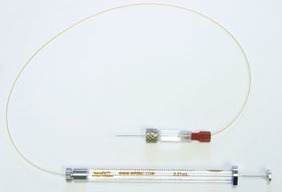
The needle is mounted on a small plastic holder that is connected to the NanoFil by a 35cm length of flexible tubing. The NanoFil is mounted on the UMPIII pump. This configuration allows you to hold the animal in one hand and insert the needle with the other.
When the needle reaches the desired location, activate the pump using the footswitch, and the pre-programmed injection volume is delivered. This configuration gives a nanoliter level of accuracy and reproducibility. It is best suited for applications such as the RPE (Retinal Pigment Epithelial) and IO (Intra Ocular) injection.
Needle Types
The replaceable needles used with the NanoFil are available with either blunt or beveled tips. The blunt tip is used for injection into soft tissue and when a uniform solution distribution is needed. The beveled style is used for applications that involve the penetration of a tough tissue.
One of the main factors that limit the resolution and accuracy of conventional micro syringes to the upper tens of nanoliters range is diffusion in the large tip ID. When the tip ID is equal or larger than 100 micron, the error caused by tip diffusion is in the nanoliter range level [(100 micron)^3 = 1 nanoliter]. With a 36 gauge needle installed on the NanoFil, the error caused by diffusion will be reduced to the sub-nanoliter level, making accurate injection of a nanoliter possible.
All of WPI’s beveled tips have a unique 25 degree tri-surface bevel that is optimized for microinjection. A 10 degree single-surface beveled tip penetrates better than one with a 25 degree angle, however the distance between the upper opening to the tip (the dimension “F” in the drawing above) is longer. As a result, it requires a deeper penetration of the tip to achieve the same level of liquid delivery. Deeper penetration means more tissue damage. WPI’s unique 25 degree beveled tip solves this problem with two extra beveled surfaces. The tip of a single surface beveled tip is actually a blade instead of a point. It dulls very quickly. In contrast, the tri-surfaced tip has a real point. It not only penetrates much better but is also much more durable. Our tests show that our 33 gauge, 25 degree beveled tip penetrates easier and lasts longer than other manufacturers’ 33 gauge, 10 degree single beveled tips. With a 35 gauge tri-surface beveled tip, the resistance to the penetration becomes even less. Each of our tips undergo a penetration test before leaving the factory to guarantee the best results for our customers.
33 gauge: This tip is similar to Hamilton's 7762 and 7803 series removable needles in both tip length and outer diameter. However, our beveled tip version is shorter, more durable, and penetrates better due to the special tri-surface grinding technique. In the past, 33 gauge tips were the smallest size sold by other manufacturers and were frequently cited in literature. However, our new 35 gauge tip is much better for injections involving small animals, especially mice.
Compared with Hamilton' 33 gauge, 10 degree beveled tip, our 35 gauge 25 degree beveled tip can reduce the depth of penetration by almost 80%. The distance between the tip and the upper rim of the opening is 348 microns for the 33 gauge tip. The distance for our 35 gauge tip is only 230 microns. In addition, the smaller tip size significantly reduces the required penetration force. In nearly all applications, a 33 gauge tip can be replaced with our 35 gauge tip and produce better results.
34 gauge: This is a transitional size between the 33 gauge and 35gauge. If the 35 gauge is too weak and the 33 gauge is too large, this makes a good alternative.
35 gauge: This was the most popular and preferred NanoFil tip of most scientists during our field trial. The combination of its strength, length, durability, and clogging resistance creates a balance with very little compromising of the individual properties. It is much smaller than the 33 gauge tip offered by other manufacturers. It is only slightly larger than the 36 gauge tip but is much stronger and less likely to be clogged. Samples can be directly loaded with this tip. Its 5 mm length is sufficient enough for almost all injection applications in mice.
36 gauge: This is the smallest tip that is commercially available. The tip is so small that it can be inserted into the opening of the 33 gauge needle tip. Because this is pushing the limits of what current technology can produce, there are some limitations to consider before using. Its thin diameter makes it necessary to limit its length to 2.5 to 3.0 mm and still maintain a usable strength. Since the tip ID is in the 25 to 50 micron range, it is very easily clogged. Therefore, only well filtered solutions can be used. We recommend using the 35 gauge tip instead of the 36 gauge, unless it is absolutely necessary.
Flexible Quartz Tubing: The flexible quartz tubing tip is made of 160 micron OD polyimide coated quartz tubing with a special adapter sleeve mounted at the end. It is designed for filling glass capillary electrodes or pipettes, just like WPI's traditional MF34G Microfil. However, unlike the traditional MicroFil, which has about 50 microliters of dead volume in its luer hub, the dead volume of this tip is less than 0.6 microliters. It is useful for loading electrodes with solutions that have a limited volume or are too expensive to waste.

Close


